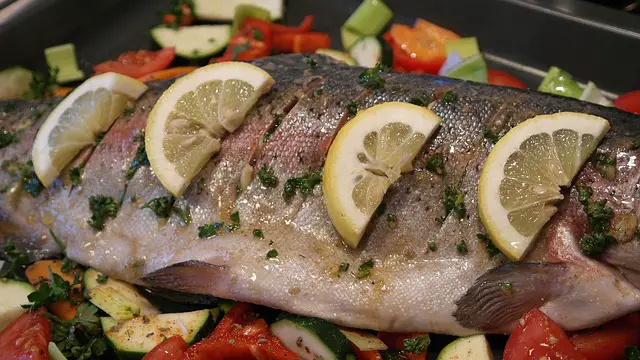Trout have tiny and soft scales which do not need to be removed before cooking. Many people barely notice them while eating cooked trout. On trout larger than 18″ it can be worthwhile to give them a quick scraping because the scales can be a bit larger.
Trout, are a popular eating fish, knowing for their delicate flavor and tender flesh. But many new fishermen wonder if they need to be scaled before cooking. In this article, I will explore the need to scale trout before cooking, addressing common misconceptions and shedding light on the importance of this step for larger specimens.
Understanding Trout Scales
Trout Scales Are Tiny
Trout possess minuscule and soft scales, which, contrary to popular belief, do not necessarily require removal before cooking. When prepared properly, these scales often go unnoticed by many diners. The delicate nature of trout scales allows for an enjoyable eating experience without the hassle of removing them.
Trout Larger Than 18 Inches Could Be Worth A Quick Scrape
However, as trout grow larger and reach a size of 18 inches or more (weighing just under 4 pounds), the scales become a bit coarse. While it is far from essential, scaling trout of this size can be beneficial. The larger scales might affect the overall texture and appearance of the cooked fish, leading some individuals to opt for a quick scraping before cooking.
Insights from Trout Anglers
To Scale or Not to Scale?
In a recent poll conducted within an online trout fishing group, nearly two-thirds of trout anglers admitted to not scaling their trout before cooking. This insight reveals the prevalent practice of leaving the scales intact, emphasizing their inconspicuousness during consumption.
The Significance of Trout Scales
The Fine Art of Trout Scales
When touched, they feel smooth, almost slimy, this distinguishes them from the scales of many other fish species.
These fine scales contribute to the trout’s streamlines. Allowing them to thrive in fast-flowing waters. However, these fine scales, and the corresponding membrane layer also make trout more susceptible to fungal infections and damage resulting from rough handling during catch-and-release practices.
Scaling Other Salmonids
Steelhead, Salmon, and Large Char: Scales and Culinary Considerations
The good news for seafood enthusiasts is that even larger salmonids, such as Steelhead, Salmon, Lake Trout, or Arctic Char, usually have relatively fine scales. While not commonly consumed with the skin, if you decide to keep and cook these fish, a light scraping with a knife to remove the largest scales is advisable, enhancing the overall eating experience.
How To Cook Crispy Trout Skin
Trout skin, when fried to perfection, can be a delectable treat. Often considered a delicacy, the skin crisps up beautifully with a light sprinkling of salt. Leaving the scales on during the cooking process is perfectly acceptable, as they blend seamlessly into the dish, allowing diners to relish the flavors without noticing their presence.
Ingredients:
- Fresh trout skin (Normally lift over after filleting)
- Salt, to taste
- Cooking oil (such as vegetable or canola oil)
Instructions:
- Prepare the trout skin: Ensure the trout skin is clean and free from any remaining scales. Pat the skin dry with a paper towel to remove excess moisture.
- Score the skin: Using a sharp knife, lightly score the trout skin in a diagonal pattern. This helps prevent the skin from curling up during frying and ensures even cooking.
- Season the skin: Sprinkle salt evenly over the scored side of the trout skin. Adjust the amount of salt according to your taste preferences.
- Heat the oil: In a frying pan or skillet, heat a generous amount of cooking oil over medium-high heat. The oil should be hot but not smoking.
- Fry the trout skin: Carefully place the seasoned side of the trout skin down into the hot oil, ensuring it lays flat. Allow it to cook for approximately 2-3 minutes or until it turns golden brown and crispy. Flip the skin and cook the other side for an additional 2-3 minutes.
- Drain excess oil: Once the trout skin is golden brown and crispy, carefully remove it from the pan using a slotted spatula or tongs. Place it on a paper towel-lined plate to drain any excess oil.
- Serve and enjoy: Transfer the fried trout skin to a serving platter and let it cool slightly. Serve it as a crispy appetizer or as a delightful accompaniment to your main dish. Enjoy its unique texture and rich flavor!
Note: You can experiment with additional seasonings or spices, such as paprika, garlic powder, or lemon zest, to enhance the flavor of the fried trout skin.
Safety and Consumption
A Matter of Safety: Eating Fish Scales
Rest assured, fish scales, including those of trout, are safe to consume. However, larger scales might provide a slightly crunchy texture that some individuals may find less desirable. It is essential to cook fish thoroughly, as raw scales are not recommended for consumption.
Conclusion: In conclusion, scaling trout before cooking is a personal preference, influenced by factors such as trout size and individual culinary choices. While smaller trout can be enjoyed with their scales intact, larger specimens may benefit from a quick scraping. Regardless, trout scales pose no harm if consumed, and their presence adds to the natural beauty and adaptability of these magnificent fish.

